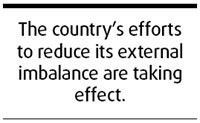Trade surplus fall
(China Daily)
Updated: 2008-04-14 07:14
Updated: 2008-04-14 07:14
The negative trade drag in the first quarter is now slowing China's economic growth. It is a needed step to reduce the country's excessive dependence on export for growth. Policymakers should make good use of the shrinking trade surplus to fight both economic overheating and runaway inflation.
Latest statistics from customs show that China's trade surplus fell by 10.9 percent year on year to $41.4 billion for the first three months of the year, marking the first quarterly decline in three years.

During China's rise as a global manufacturing power in recent years, strong growth of the trade surplus contributed significantly to the country's double-digit growth in the last five years.
However, just after the country revised its GDP growth for 2007 from 11.4 percent to 11.9 percent, the highest in more than a decade, the growth momentum of net exports turned negative, putting a drag on the national economy.
A slowdown of the export sector had long been expected as the Chinese authorities continuously slashed tax rebates to rein in export of energy and resource-intensive products. It is believed that lower trade growth will not only help cool export-led investment to prevent the economy from overheating but also facilitate the nation's drive to raise energy efficiency and cut pollution.
In this sense, the deceleration of the trade surplus growth in the first quarter is a welcome sign that the country's efforts to reduce its external imbalance are taking effect.
But the speed at which robust trade surplus growth has turned negative also appears to be faster than most people expected, making it more difficult for Chinese exporters to swallow.
A rebound of exports last month to nearly $109 billion, up 30.6 percent year on year, might indicate that the trade sector has survived unfavorable seasonal factors like the Spring Festival and the snowstorms that seriously curtailed the growth rate of exports in February.
Nevertheless, the combination of the fast appreciation of the Chinese currency that just broke the 7-yuan mark against the US dollar and a US-led global slowdown that shows no sign of ending, has proved a bigger challenge than Chinese exporters thought.
Chinese policymakers should certainly prepare to cushion some labor-intensive exporters from a sharp drop in overseas orders. But it is still too early to take action as the country's trade surplus growth has only just turned negative. It is noteworthy that faster import growth in the first quarter was primarily driven by higher commodity prices rather than bigger domestic demand.
(China Daily 04/14/2008 page4)
|
|
|
|